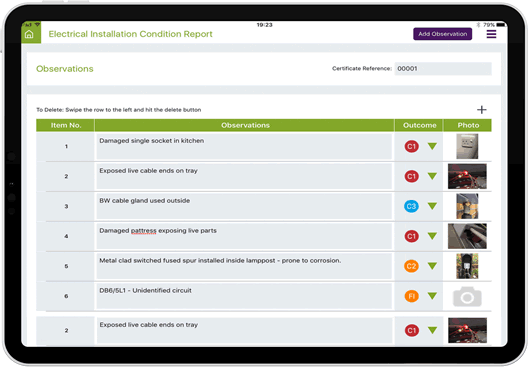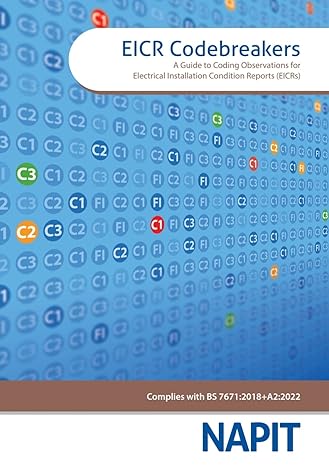How to code observations for an EICR
The coding of observations and non-compliance’s found during an Electrical Installation Condition Report (EICR) to the fixed wiring is a serious matter because an incorrectly coded observation could result in deeming an unsatisfactory installation as satisfactory.
It is the responsibility of the person carrying out the inspection to allocate an appropriate code, Code C1, Code C2, Code C3 or Code FI to each of the defects found during the inspection.
The person carrying out the inspection should have an in-depth knowledge of the current version of BS 7671 IET Wiring Regulations and Guidance Note 3 Inspection & Testing.
Depending on the type of electrical installation other BS Standards and Approved Building Documents may also apply.
In addition to the above requirements the electrical inspector should be fully competent, highly skilled, suitably qualified and extensively experienced in testing and inspecting the particular type of electrical installation they are reporting on.
In this EICR coding guide we hope to clarify the various EICR code meanings and definitions.
What do EICR codes mean?
The four main EICR codes are C1, C2, C3 and FI.

C1 = Danger present
A code 1 observation must be rectified and made safe without delay.
An example of a C1 observation (it’s dangerous now!) would be the cover of a consumer unit missing hence exposing live parts. Any exposed live parts such as an open consumer unit busbar or an exposed live cable end would be classed as a code 1, as it is dangerous (right now) at the time of the inspection.
C2 = Potentially dangerous
A code 2 observation must be rectified as a matter of urgency.
An example of a C2 observation (potentially dangerous) would be no RCD protection to an external 13A socket. A C2 potentially dangerous observation extends to any potential dangers, hazards or risks which could occur under certain conditions or under fault conditions such as, this could become dangerous should that happen.
C3 = Improvement recommended
A C3 observation is a recommendation for improvement.
A code 3 would be an observation you feel warrants a mention on the report of something you feel should be improved but would not be classed as a C1, C2 or FI.
FI = Further investigation required
An FI observation must be investigated as a matter of urgency.
Further investigation would be allocated to an observation which could be potentially dangerous but could not be determined at the time of the inspection, therefore requires further investigation into the defect to be able to determine what code to allocate against it.
LIM = Limitation (not tested or inspected)
An inspection report schedule of items inspected may include “LIM”, meaning a limitation has been applied to the inspection.
A limitation (LIM) noted on a condition report means that a particular item(s) and / or circuit(s) have not been tested or inspected. This could be due to no access to a particular area of the installation such as a server room, therefore the circuit supplying the server room could not be tested or inspected hence a limitation has been applied.
A limitation could also be a pre-agreed limitation agreed with the client, i.e. the client does not want you to test or inspect that specific area or item.
Another example of a limitation could include high level warehouse lighting, if there is no safe working access to the high level lighting then a limitation might be applied.
NOTE = A noteworthy comment.
An item the inspector has deemed noteworthy but not necessarily related to electrical safety, a “NOTE” has no bearing on the outcome of an inspection.
EICR Software
In the age of fast moving technology there seems to be an app for almost everything now and that includes Electrical Certification Software, download it today and start your free trial.

Electrical Certification Software based on BS 7671 and BS 5266.
Windows | iPad | Android Tablets
EICR Coding Guidance
To assist electricians in deciding which code to allocate to an EICR defect or observation there are a number of publications on the market which aim to assist you in your your decision making.

Guide to Initial Verification and Periodic Inspection and Testing of Electrical Installations from NAPIT covers everything you need to carry out initial verification and periodic inspection, including the tests and production of the relevant certificates or report.

EICR Codebreakers by NAPIT is a guide to assist with the classification of observation codes for an EICR.
EICR Pass or Fail
It is the responsibility of the person carrying out the inspection and testing to determine and allocate either a C1, C2, C3 or FI to each defect / non-compliance found (if any) in their professional judgement.
Professional judgement means the application of relevant training, knowledge and experience, within the context provided by auditing, accounting and ethical standards, in making informed decisions about the courses of action that are appropriate in the circumstances of the audit engagement.
There are only two outcomes of an Electrical Installation Condition Report (EICR), formally known as a Periodic Inspection Report (PIR), and they are SATISFACTORY or UNSATISFACTORY.
If an observation has been allocated either a C1, C2 or FI code then the installation must be deemed to be unsatisfactory.
If no code 1’s, 2’s or FI’s have been noted but a number of code 3 observations have been made then the installation can be deemed to be satisfactory as long as the inspection and testing has been carried out thoroughly and there are not too many limitations (LIM) applied.
An Electrical Installation Condition Report which has been deemed as Unsatisfactory is essentially a fail, meaning at least one C1, C2 or FI observation has been identified.
An Electrical Installation Condition Report which has been deemed as Satisfactory is essentially a pass, however the electrical inspector may have identified items for which they recommend improvement (C3).
Which edition of BS 7671 should I test and inspect to?
When carrying out an Electrical Inspection of an existing electrical installation you should always inspect and test to the current edition of BS 7671, irrespective of when the installation was originally installed, be that 2 weeks ago or 50 years ago, we always test to the current version of the Wiring Regulations and Guidance Note 3.
It is responsibility of the person carrying out the inspection to allocate a suitable code for any identified defects based on their own professional judgement.
EICR Code Differences in Opinion
Sometimes Electricians and Inspection/Testing Engineers interpret the wiring regulations differently and will have different opinions on which code to allocate to an observation.
The person who actually conducted the inspection is the person who is to decide which code to allocate.
Too many times end-clients post the results of their unsatisfactory EICR reports online on the hope to get advice from other electricians to de-classify or re-classify EICR codes in order to obtain a satisfactory EICR, or at least reduce the amount of remedial works required.
While there is no issue of seeking a 2nd or 3rd option, in fact, sometimes it is recommend to get a second opinion if the issued report does not appear to have been completed properly, but Electricians can’t really offer their professional judgment on an EICR code without actually seeing and inspecting the issue themselves.
EICR Codes
- C1 = Danger Present (FAIL)
- C2 = Potentially Dangerous (FAIL)
- C3 = Improvement Recommended
- FI = Further Investigation Required (FAIL)
- NOTE = An item the inspector has deemed noteworthy but not necessarily related to electrical safety
Additional codes which you might find on the schedule of items inspected section of the electrical report might include,
- N/V = Not Verified.
- N/A = Not Applicable.
- LIM = Limitation.
- PASS = Passed.
- FAIL = Failed.
Instead of using N/V for an item which could not be verified, it might be more appropriate to code it as an FI.






